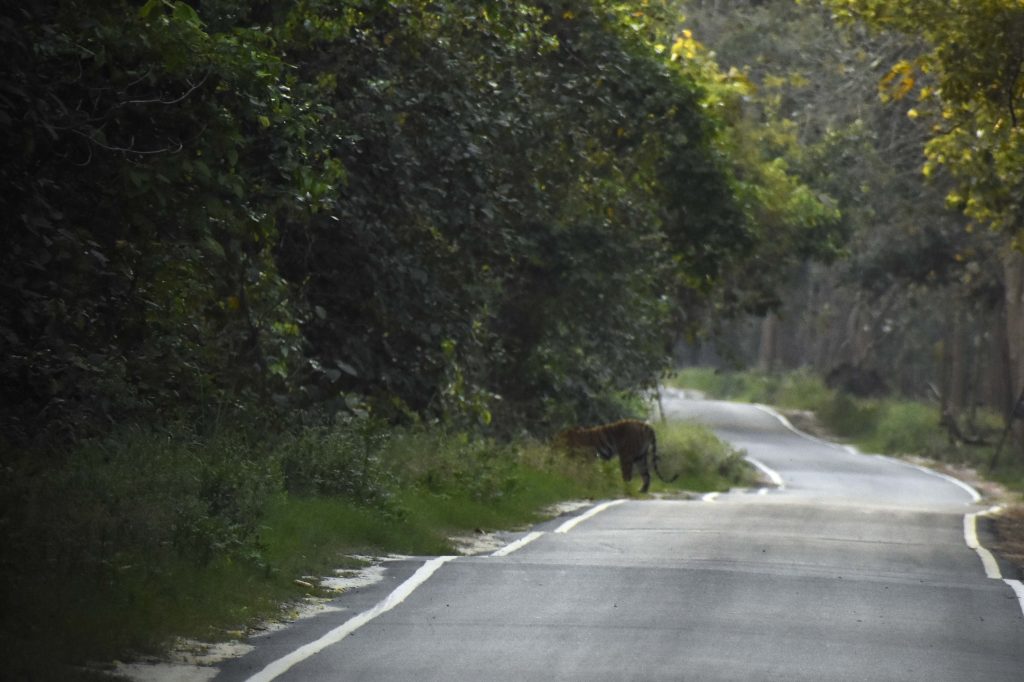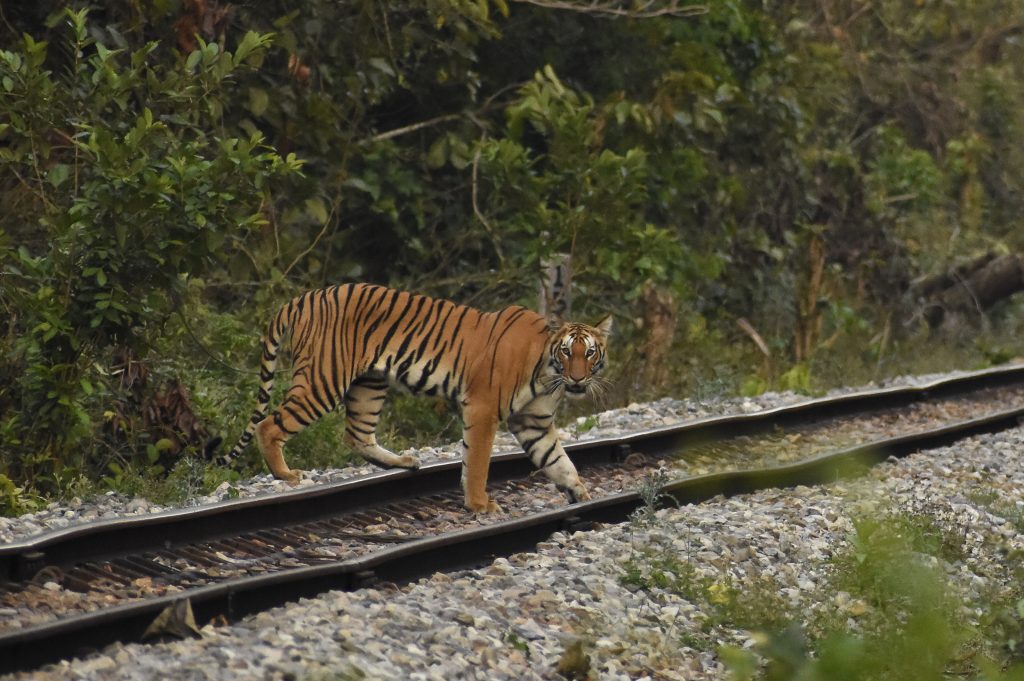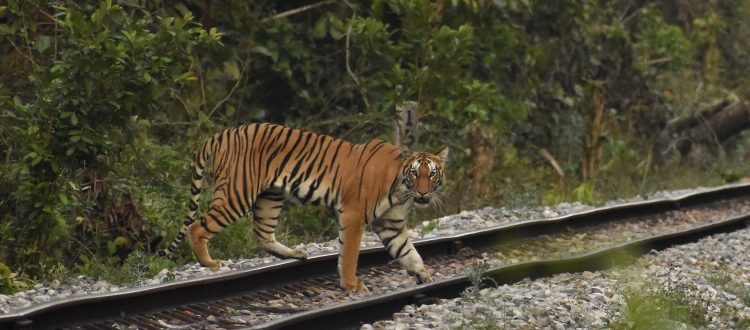Stripes on track – My first tiger sighting in Katerniaghat
As a field officer, I find field visits to be the most important and exciting part of my daily routine. Depending on where I am on assignment, the landscapes, culture and people around me constantly change. As part of my training, I was recently sent to Katarniaghat to join the Rapid Response Team (RRT) of Wildlife Trust of India’s (WTI) ‘Terai Tiger Project’. The sudden transition from Wayanad in Kerala to Katarniaghat in the Indo-Nepal Border had a profound impact on me. The language I heard, the food I ate, and even the air I breathed felt completely new. Each day became an opportunity for me to learn and appreciate something different.
However, this particular evening has stuck with me ever since. During a field visit, my colleagues and I were traveling from Mihinpurwa to Majhra Purab. The road took us through the heart of Katarniaghat Wildlife Sanctuary, where the dense vegetation on both sides of the road was a sight to behold. The sanctuary, located in the Upper Gangetic plain near Bahraich in Uttar Pradesh, India, spans an area of 400.6 km2 (154.7 sq mi) in the Terai region of Bahraich district.

Tigress crossing a road in Katerniaghat | Photograph by Sujnan MK
What’s that animal!
I have reach several project reports where it speaks about how the forests of Katarniaghat plays a crucial role in connecting the tiger habitats of Dudhwa and Kishanpur in India with the Bardiya National Park in Nepal. Its delicate ecosystem that hosts a mosaic of sal and teak forests, lush grasslands, numerous swamps, and wetlands. This sanctuary is home to several endangered species, including the Gharial, Gangetic Dolphin, Swamp Deer, Hispid Hare, Bengal Florican, White-rumped Vulture and Long-billed Vulture. I witnessed several troops of Langurs, Bonnet Macaques, and Spotted Deer. I thoroughly enjoyed observing these animals, and capturing such moments with my camera. Although deer and langurs were not new subjects for my photography, little did I know that the forest of Katarniaghat had something special in store!
As we continued our journey, we noticed a solitary animal walking along the roadside, approximately 200 meters away. Although the view was not entirely clear, we speculated that it could be a tiger, and excitement spread among everyone in the vehicle. Anticipating that we might lose sight of the animal, I made a few photos to refer later. As we approached closer, the animal seamlessly blended into its surroundings, and I silently acknowledged our missed opportunity. Driving ahead, we carefully scanned the area in hopes of catching another glimpse. Regrettably, it seemed to have disappeared. Adjacent to the road however, there was a railway track, running parallel, with a mere 10-meter gap filled with dense vegetation. It was into this verdant cover that the tiger had vanished. Considering its potential movement, we surmised that it might cross the track and venture into the other side of the forest. Intrigued by this possibility, we positioned ourselves near the tracks and patiently awaited the tiger’s next move.

Tigress crossing Railway line in Majhra Purab in Katerniaghat WLS | Photograph by Sujnan MK/WTI
Minutes ticked by as we eagerly scanned the area. There was a possibility that the animal might have already crossed the track. But, just as we were about to leave the spot, our attention was drawn to a low bush, where the animal was lying well-camouflaged! It seemed to be in a state of caution, meticulously observing both sides, much like we humans do when crossing a road.
A few minutes later, it gracefully stepped onto the railway track, exhibiting its majestic and mesmerizing presence. It was a breathtaking sight to witness a beautiful sub-adult tigress emerging into the open. The tigress too had acknowledged our presence, delicately fixing its gaze upon us for a few seconds before proceeding to cross the tracks, disappearing once again into the depths of the forest. This encounter marked the most remarkable tiger sighting of my life and also the first tiger photograph I had ever captured.
The track of no-mercy
The railway track that cuts through the heart of Katarniaghat Wildlife Sanctuary holds significance within the sanctuary’s core forest area. This single-line track stretches from Bahraich to Mailani, spanning a distance of 205 km. Throughout the day, four trains operate between 7:00 a.m. and 6:00 p.m., and on weekends, two tourist trains cater to the visitors to the landscape. Observing a tiger crossing the track was truly incredible. However, it raised concerns about the potential threats these magnificent creatures face in such an environment.
Although tigers have adapted to the presence of the railway track, it does disrupt their natural movements. The current train frequencies already pose challenges, and any increase in the number of trains in the future could pose a serious threat to the tigers and other wildlife residing in the sanctuary. Disturbingly, reports indicate that between 2017 and 2021, over 63,000 animals were tragically killed on rail tracks. These statistics serve as a sobering reminder of the dangers wildlife face in relation to railway infrastructure.
As we continued our journey, my thoughts remained fixated on the railway track. Could these magnificent striped creatures truly survive amidst the tracks and the associated challenges they pose? Will I be able to see the tigress again? It was a lingering question that stirred my mind, emphasizing the need for conservation efforts to address the potential risks and find sustainable solutions. Hopefully, I will understand more as I continue to explore more with my team.
Read another amazing story of tiger encounter here!









